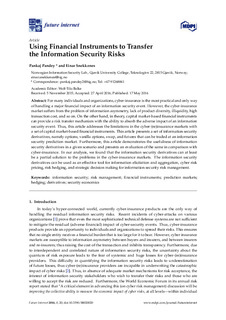| dc.contributor.author | Pandey, Pankaj | |
| dc.contributor.author | Snekkenes, Einar | |
| dc.date.accessioned | 2020-03-06T13:11:06Z | |
| dc.date.available | 2020-03-06T13:11:06Z | |
| dc.date.created | 2016-05-26T14:59:26Z | |
| dc.date.issued | 2016 | |
| dc.identifier.citation | Future Internet. 2016, 8 (2), . | nb_NO |
| dc.identifier.issn | 1999-5903 | |
| dc.identifier.uri | http://hdl.handle.net/11250/2645842 | |
| dc.description.abstract | For many individuals and organizations, cyber-insurance is the most practical and only way of handling a major financial impact of an information security event. However, the cyber-insurance market suffers from the problem of information asymmetry, lack of product diversity, illiquidity, high transaction cost, and so on. On the other hand, in theory, capital market-based financial instruments can provide a risk transfer mechanism with the ability to absorb the adverse impact of an information security event. Thus, this article addresses the limitations in the cyber-(re)insurance markets with a set of capital market-based financial instruments. This article presents a set of information security derivatives, namely options, vanilla options, swap, and futures that can be traded at an information security prediction market. Furthermore, this article demonstrates the usefulness of information security derivatives in a given scenario and presents an evaluation of the same in comparison with cyber-insurance. In our analysis, we found that the information security derivatives can at least be a partial solution to the problems in the cyber-insurance markets. The information security derivatives can be used as an effective tool for information elicitation and aggregation, cyber risk pricing, risk hedging, and strategic decision making for information security risk management. | nb_NO |
| dc.language.iso | eng | nb_NO |
| dc.publisher | MDPI | nb_NO |
| dc.rights | Navngivelse 4.0 Internasjonal | * |
| dc.rights.uri | http://creativecommons.org/licenses/by/4.0/deed.no | * |
| dc.title | Using Financial Instruments to Transfer the Information Security Risks | nb_NO |
| dc.type | Journal article | nb_NO |
| dc.type | Peer reviewed | nb_NO |
| dc.description.version | publishedVersion | nb_NO |
| dc.source.pagenumber | 62 | nb_NO |
| dc.source.volume | 8 | nb_NO |
| dc.source.journal | Future Internet | nb_NO |
| dc.source.issue | 2 | nb_NO |
| dc.identifier.doi | 10.3390/fi8020020 | |
| dc.identifier.cristin | 1357791 | |
| dc.description.localcode | c 2016 by the authors; licensee MDPI, Basel, Switzerland. This article is an open access article distributed under the terms and conditions of the Creative Commons Attribution (CC-BY) license (http://creativecommons.org/licenses/by/4.0/). | nb_NO |
| cristin.unitcode | 194,63,30,0 | |
| cristin.unitname | Institutt for informasjonssikkerhet og kommunikasjonsteknologi | |
| cristin.ispublished | true | |
| cristin.fulltext | original | |
| cristin.qualitycode | 1 | |

